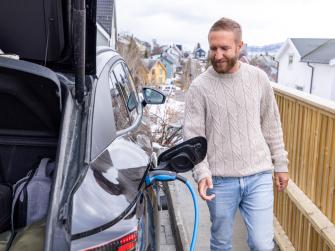Have questions about electric cars? Our EV expert has answers.
Electric vehicles are helping the world cut pollution.
As we see more of them on the road, you might be wondering: Do EVs really help people save money? Do they work in cold weather? Are they actually better for the environment? (Spoiler: Yes, yes and yes!)
Neda Deylami, a clean vehicle expert at EDF, recently took time to answer these and other common questions about EVs.
An attorney, Deylami has helped make it easier for renters, condo owners and others in her home state of Illinois to charge their electric vehicles — right at home.
She also drives an EV herself — and loves it so much that she started giving what she calls “EV 101” talks at local libraries and events to share what she knows with the EV-curious.
Q: Can I really save money by driving an EV?
A: Yes! Because of lower fuel costs and maintenance needs, electric vehicles can definitely save you money and have a lower total cost of ownership than their gasoline-powered counterparts.
Electricity has a much more stable and affordable cost than gas. Those who can plug in at home can take advantage of utility incentives like off-peak and time-of-use pricing to save even more. Or, charge your car with free electrons from the sun using solar power.
Q: What are some other benefits of electric cars, trucks and buses?
A: Transportation is the largest source of greenhouse gas emissions in many parts of the world, so electrifying cars, trucks and buses is a key tool to fight climate change.
Electric cars also give us cleaner air. Gasoline and diesel vehicles pollute the air with dangerous nitrogen oxides and particulate matter in their exhaust, while EVs do not have tailpipes to pollute our air.
EVs are also quiet, odorless and fun to drive, with instant torque and intuitive one-pedal driving. There’s a reason that, of American EV drivers surveyed, 92% said their next vehicle would likely be an EV again.

Q: Is an EV cleaner than a gasoline-powered vehicle today, even in cases where we’re burning coal for electricity to charge it?
A: Yes, by and large, over the life of the vehicle, the total emissions of EVs are lower than for similar cars that run on gasoline — even in places where coal may make up most of grid power supply. As the supply of renewable energy continues to grow, EVs can capture even more emissions reductions from the grid.
Although manufacturing EVs initially produces more emissions, the lifetime emissions of EVs are lower than for gasoline-powered equivalents after about two years of ownership in the United States. Most people keep their vehicles much longer than two years.
EVs are several times more energy efficient than gasoline vehicles, converting around 90% of the energy from the battery to move the wheels. Compare that to gasoline vehicles, which are so wasteful at only about 20% efficiency that every $40 worth of gas you buy may only use $8 worth to actually move the car — wasting the remaining $32.
Q: What about the minerals needed for batteries, given their scarcity and the impact of mining them?
A: Lithium-ion batteries, which are used in EVs among other electronics, are indeed resource-intensive. Some of their parts are critical minerals extracted in dangerous and destructive mining practices. There’s work to do to build a cleaner supply chain that protects not only the environment, but also human rights and workers’ rights.
The good news is that battery technology is adapting, with more batteries built with less or no cobalt or nickel, which have steep environmental and societal costs. Plus, EV batteries have long, useful lives: They can last longer than the vehicle they are in, serving second lives as battery storage.
Once their useful life is done, EV batteries can be recycled, a rapidly growing industry globally. This means that batteries can one day be part of a circular economy with decreasing extraction needed — whereas gasoline vehicles require continual drilling for oil.
Q: Do EVs work in cold weather?
A: Absolutely, just look at Norway, where nearly all new vehicles sold are EVs.
First, all types of vehicles use more energy in cold weather (and diesel fuel can even coagulate inside a tank in freezing temperatures).
Extreme cold means reduced range, which for EVs may just mean planning ahead a little. Simple steps like warming up your car before you drive it can help, as it “preconditions” the battery for faster charging on the road. More abundant public charging infrastructure can also help address hiccups with cold weather.

Q: Can you talk more about charging? Is range anxiety still a concern?
A: When I first got an EV in 2017, my car had an average range of 85 miles. Since then, technology has advanced leaps and bounds to the point where a similarly sized and priced EV today has a 300-plus mile range.
Even electric semi-trucks have up to 500-mile ranges. EV ranges today far exceed average daily commutes, and with home charging, you cannot beat the convenience of waking up with a “full tank” and never having to go to a gas station.
For those who must rely on public charging and people on longer trips, public charging infrastructure is growing rapidly and can be found wherever electricity is — often at shopping malls, restaurants, grocery stores and businesses in urban areas and right off the highway. Surveys of American EV owners have found range anxiety concerns to largely dissipate after actually owning an EV.
Q: Does getting an EV make sense if I live in an apartment?
A: Home charging in a single-family home is definitely the most convenient and turnkey-ready way to charge, but renters and condo owners can also enjoy EV ownership.
I know this because I’ve lived it. I’m an apartment-renting EV owner. When I first got an EV, I had no off-street parking and used a free charger at a nearby grocery store. Now, I plug in overnight in a regular outlet in the parking space that comes with my apartment.
If off-street parking is available, you may be able to find a suitable outlet to plug your car into. In many American states, EV drivers have a “right to charge,” prohibiting unreasonable restrictions on charging from landlords or homeowner associations.
Many building codes require or encourage new homes and businesses to be built “EV-ready” to avoid costly retrofits later.
Q: Why is there so much buzz around electric trucks and buses?
A: Medium- and heavy-duty vehicles — which are trucks, buses, delivery vans and the like — make up a disproportionate amount of transportation-related air pollution.
This means that every electric truck or bus gives a bigger bang for buck when it comes to reducing pollution. Plus, these vehicles tend to operate in fleets with predictable schedules and stay within a relatively close radius to their depots, or are able to share charging infrastructure, so there is not as much need for public charging stations for these vehicles.
Q: You drive an EV. Why do you love it?
A: My first EV was my first car ever, so I’ve never had to think about gas prices or oil changes or what a spark plug is. I love not contributing to air pollution in my community and helping the planet while having fun driving.
I also grew up riding diesel school and transit buses, so I love seeing electric buses that do not cough up smog on kids, pedestrians and cyclists. It is simply a better way to power our transportation, and I want everyone to enjoy its benefits.










